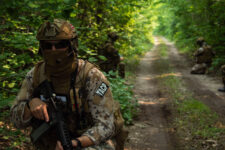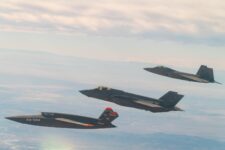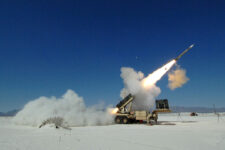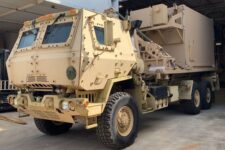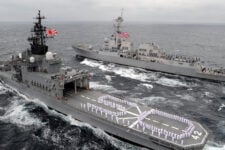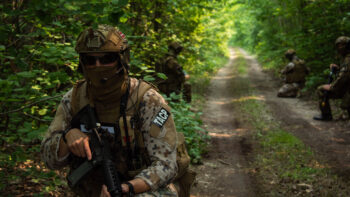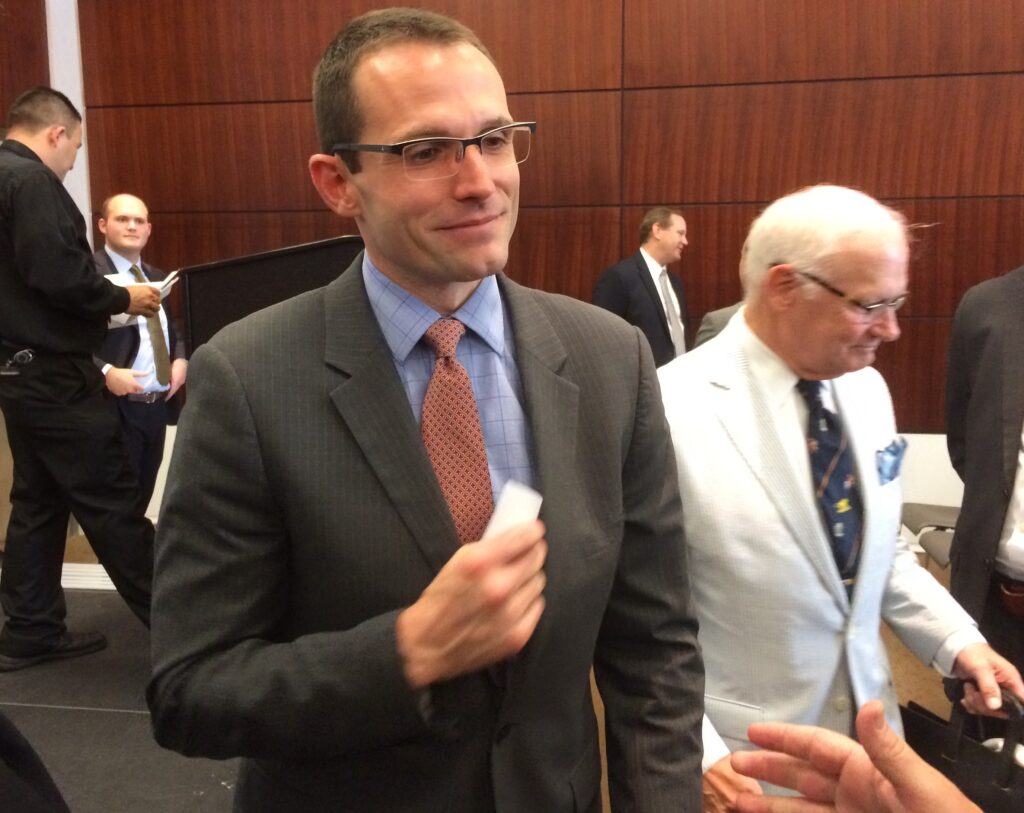
William Roper reaches for a business card for yet another supplicant after a talk at CSIS.
WASHINGTON: William Roper’s Strategic Capabilities Office is exploring some of the most innovative concepts in the US military. Imagine a militarized version of Pokémon Go, helping Army soldiers locate real-life threats instead of cartoon monsters. Imagine robot brains in a box — an “autonomy kit” — that Navy sailors can install on a patrol boat so it can operate without a crew. Imagine Marines using modified “big data” marketing software to track anti-American sentiment and predict dangerous developments instead of what people buy.
“The big data tools… are in beta testing today and I think will be ready for prime time within a year,” Roper told me in a rare interview. The autonomy kits are works in progress, he said, while augmented reality for combat troops (a la Pokémon Go) is more nascent.
Roper doesn’t see himself as a revolutionary, however. He’s more like MacGyver, frantically jury-rigging gadgets from whatever’s at hand to stop the bad guys. In a world where America’s adversaries are exploiting rapidly advancing, widely available technology to erode our military advantages, Roper is buying time.

Defense Secretary Ash Carter talks to Strategic Capabilities Office director William Roper at Submarine Base New London.
Buying Time for the Offset Strategy
\DARPA and Defense Department labs are developing breakthrough technology as part of the Pentagon’s Third Offset Strategy. A central theme is autonomous artificial intelligence — operating both in real-world robots and in cyberspace — but there is also promising work in hypersonic missiles, 3-D printing, and other areas. There’s just one problem: time.
“I’m really impressed with a lot of the technologies that those groups are working on, but it does take time to get them out to the field,” Roper told me. So, with potential adversaries striving mightily to catch up, he said, “SCO is working on the front end in a buying-time role for the Department.”
The premise of the Third Offset Strategy is that modern American military supremacy rests on inventions made in the 1970s — stealth, smart bombs, wireless digital networks — and it’s past time to start working on the next generation of revolutionary technologies. The premise of the Strategic Capabilities Office is that, in the meantime, there’s plenty of room for improvement in the current generation.
“We have over a trillion dollars’ worth of sunk costs in the systems we have bought and operated, (and) there’s a lot of potential under the hood to modify these systems,” Roper said. “Our job, instead of looking forward to the future technologies that are coming out of the research shops, is to look backwards to the systems that we currently have.”
“These two things dovetail,” Roper went on. “Let’s say we buy the Department 10 years or 15 years of time (in which) the current systems will still have sufficient surprise and unexpected capabilities to be able to win future conflicts. That’s 15 years for the technology shops (to work on) programs that they can fast-track and move to field, so by the time that we’ve exhausted all of our ideas, there’s a new set of ideas.”
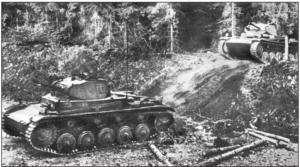
German Panzers cross the Ardennes to take French forces by surprise, 1940.
Roper’s favored analogy is World War II. The breakthrough inventions of that war — chiefly airplanes, tanks, submarines, and radios — had first been used in battle twenty years before, in World War I. (Radar is a partial exception, since it was an offshoot of radio). Germany overran Europe not because it had better technologies but because it combined them better. Once the Russians, for example, figured out what the Germans had done, they had the technology to emulate it and blitz the Germans back.
All the major powers had the same basic technology, Roper argued, and that baseline stayed “static” until the US exploited revolutionary physics to develop the atomic bomb. Yet between 1939 and 1945, there were tremendous advances in combat power as hard-won combat experience and engineering trial-and-error found the best ways to use the same underlying technology.
“In World War II, almost every idea was wrung out. It had to be in order to keep advantage,”: said Roper. Since 1945, however, US military technology has never been put so thoroughly through the wringer. That problem is a byproduct of success — we managed to deter the Soviets instead of fighting them, and no foe since has threatened us with extinction — but it’s still a problem.
“That natural wringing-out function that was performed in World War II has not been performed with the last generation of systems,” Roper said. SCO will help the services with “wringing out all the dregs of the things that we have, before we come in and say we need a new thing.”

How SCO Works
When speed is the priority, the trick is to combine existing technologies in new ways, especially by bringing rapidly advancing commercial technology into the slower-moving military world.
Of the 23 projects (many classified) that SCO has worked on so far, said Roper, the typical time from initiation to completion is three years. That’s a lightning pace for a Pentagon that measures major development programs in decades.
“Most of the capabilities that we work tend to be one to four years. Five years is not too long for us,” Roper told me. “If a fantastic idea were to come in that took six years to do” — and nobody else in the Defense Department were doing it — “I would not exclude taking it on, but I’d have a higher burden of proof.”
SCO doesn’t have and doesn’t want a hard-and-fast rule for what kind of projects it can take on, Roper emphasized. It doesn’t even issue formal requirements, which usually serve as holy writ for Pentagon acquisitions.
“I was asked … I’m going to have to say at least 500 times during the first year, ‘what’s your requirement?’” Roper said at the Center for Strategic & International Studies last week. “The best thing about running my office is that I have no requirements. I have a mission, kind of like the guys in World War II.
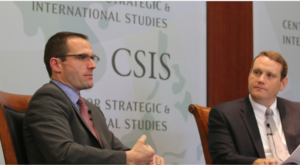
Roper with Andrew Hunter at CSIS.
Requirements all too often become a sacred straitjacket, preventing intelligent trade-offs.
“Where we often trip ourselves up is we write down numbers that we wish were true…but then once they take on the word ‘requirement,’ it means that they have to be,” Roper said at CSIS. The current system tends to lock specs down too early — range, speed, accuracy, etc. — without room for tradeoff.
Roper doesn’t even have a normal budget. SCO gets a flat $16 million a year for its analysis and testing overhead, but every specific project has to earn its own way into the Pentagon budget, he said at CSIS: “If I’m not putting new concepts in, eventually we evaporate and go away.”
So what kinds of new concepts is Roper pushing? We’ll delve into those details — robot boats, big data, and augmented reality — tomorrow in Part II. [Click here to read the second part of the story.]
No service can fight on its own: JADC2 demands move from self-sufficiency to interdependency
Making all-domain operations a warfighting capability means integrating, fusing, and disseminating a sensor picture appropriate for a particular theater segment, not all of them, says the Mitchell Institute’s David Deptula.
